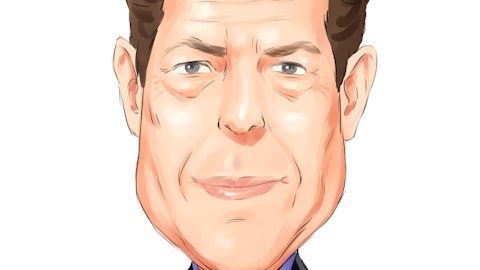There are benefits to both of those structures. We offer both of those structures, and we think it’s very important that clients continue to have the ability to choose whether they want to operate on a pass through or on a spread model.We are seeing very good interest in the PBM in the selling season. I mean, it’s very early on in most of the business, particularly in the parts of the market where we compete the most strongly happens in the middle to the back part of the selling season. But at this point in the year, we are seeing greater interest. And we’re getting really good feedback from the consulting community and others about the offering that we can bring relative to other players in this space.I think we do have a very strong reputation around being transparent with our clients in terms of how we price, how we keep our commitments, and how we work in partnership with our clients in managing their drug spend, and we’re looking forward to this selling season.Lisa Gill Great.
Thanks for the comments.Operator Your next question comes from the line of George Hill from Deutsche Bank. Your line is open.George Hill Yeah. Good morning, guys, and thanks for taking the question. I guess, Matt, I have a couple of questions. First, could you talk about what’s embedded in the guidance for COVID fiscal ’24? I would imagine given the roll off, the expectations are pretty de minimis. But given the expectation in ’23, we just kind of like to know what you guys are expecting to see as it relates to that?Matt Schroeder Yes. So, George, we have included in the guidance for ’24 is an assumption we’ll fill about 3 million COVID vaccine next year. And really the underlying basis for that assumption is the idea that there’ll be one shot administered sometime in the fall or winter as part of an annual immunization update.
We also expect, as I said earlier, that the profitability of those COVID vaccines is going to decrease as the industry moves to a model where you purchase the vaccines as opposed to being government funded with a dispensing fee.On the antigen test side, expecting antigen test demand to drop off pretty dramatically given that it’s no longer going to be covered as a government benefit in May. We’re still seeing strong demand, but some of that I think is people kind of rushing to get those done while still being covered. And in the latter part of the year, we expect antigen testing demand to be relatively minor.George Hill Great. And a quick follow-up, I guess. Before heading into fiscal ’24, you guys had outlaid a cost savings program as related to things like store closures, the loyalty savings program, cost savings in the PBM business.
I was wondering if you just kind of be able to update us on the outlook for those savings initiatives, kind of what was achieved in ’23 and kind of what the expectation should be in ’24?Matt Schroeder Yes, George, we had, I think, expectation about $190 million in savings for things related to those programs and we met and probably slightly exceeded those numbers. Store closures expect a lot less next year. We’re looking — we always look at the fleet, but we did about 190 store closures this year, do not expect anywhere close to that number next year. It’s not part of the program.From a payroll standpoint, we’ll continue to actively manage labor in the stores, but we’re actually as part of initiatives to grow our scripts and grow our business are going to be investing in doing some investments in talent, investments in technology.
And we do expect to drive a pretty significant cost savings from better management of indirect spend, which is going to be a focus for ’24.George Hill Okay. And then, the last one for me is, I know it’s early, but the macro reimbursement environment in pharmacy has been challenging. I don’t know if you guys have any early thoughts on what the impact of reimbursement changes will be in calendar ’24?Matt Schroeder Too early to tell. Yeah, too early to tell.George Hill Okay. I’ll hop back in the queue. Thanks, guys.Matt Schroeder Thanks, George.Operator Your next question comes from the line of William Reuter from Bank of America. Your line is open.William Reuter Good morning. I just have a couple. The first is, I think you said you realized [$70 million] (ph) of proceeds from the sale of scripts.
Can you talk about what the price per script was that you achieved on those sales?Matt Schroeder Thanks, Bill. It’s Matt. When we — both on the buy side and the sell side when we’re either purchasing scripts from independent pharmacies or when we’re selling scripts as a result of closing the store, the average is somewhere usually between $10 and $20 per script, varies dramatically based upon the specific transaction you’re doing and the specific demand in the marketplace.William Reuter That’s very helpful. And then, the last time we had heard regarding the lives under management at Elixir, you were expecting about 1.7 million for this calendar year. I don’t think I saw an update, unless it was in the slides and I missed it. Do you know what that number is right now?Matt Schroeder It’s in that ZIP code, probably a little less, like, 1.6 when you overall.William Reuter Okay.
And then just lastly for me, you reduced inventory by $40 million last year. I think you said you expect more this year. Is there a sense for any — is there any sense of magnitude for the reduction this year?Matt Schroeder Yeah. Without giving a precise number, I’d say it should dramatically exceed that $40 million. We’re really working pretty hard at kind of inventory sets in the front end, the ability to do a better job of doing our merchandising on a more regional basis, which enables us to get sharper on inventory ordering. We’re going to reduce the amount of seasonal inventory we do in the front end. And then, on prescription side, we still have a lot of opportunity to reduce the amount of brand prescription inventory that we have in the stores while still provide great service to our customers, because we get deliveries multiple times a week from our — from the customer delivery partner.William Reuter Very helpful.
Thanks for taking the questions.Matt Schroeder Thank you.Operator Your next question comes from the line of Karru Martinson from Jefferies. Your line is open.Karru Martinson Good morning. You talked to being over-levered and then had restricted your business investments in the core. I’m just trying to understand given the $225 million of CapEx, what is the hindrance here? And how do you get out from under this over-levered state?Matt Schroeder Part of the $225 million is thinking hard, Karru, about where we make those investments, and we’re making — we’re weighting those investments a lot more this year into technology investments that we believe are going to drive pretty rapid payback from the standpoint of being able to execute things like better script adherence, sharpening front-end inventory ordering, and better service delivery of Elixir and winning in the marketplace, and less on investments in the physical stores themselves.Keeping the stores, obviously, at a base level investment is important.
But just from the standpoint of thinking about quick payback, that’s really where we’re focusing that $225 million. And this year, despite the leverage ratio being at 6.5 times, we need to make these investments to really grow EBITDA significantly in ’25 and ’26, and basically, grow EBITDA to a point where we get that leverage ratio more stable. That — those are — that’s what we really need to do to get ourselves back to a leverage position where we would be more comfortable.Karru Martinson And is the plan still here to attack the front-end bonds to chip away at that maturity and take that off the table?Matt Schroeder Well, certainly the ’25 bonds are the things that were the most focused on, Karru, just given that they’re the earliest ones to mature.
I think, broader plans to be talked about as we kind of sharpen our thinking here over the next few months.Karru Martinson Okay. And just lastly, realize that as you said, opioid litigation is, shall we say, a long process. But could you help guide us in terms of where does that process play out with the States, with the DOJ, just from a from a big picture of what your expectations are, both from a cost and from a timing perspective?Elizabeth “Busy” Burr Yes. I think it’s very difficult as you can imagine to predict litigation. And all we can tell you is that what we’re facing is very consistent with everybody else in the industry is facing. We are in the process of vigorously defending ourselves and we’ve included all the costs into our guidance in SG&A.
So — and then we just — obviously, we can’t comment on the specific matters beyond what we’ve got out there probably.Karru Martinson Thank you very much, guys. Appreciate it.Operator And we have time for one last question. Your final question comes from the line of Carla Casella from J.P. Morgan. Your line is open.Carla Casella Hi. Thanks for taking the question. You mentioned $10 million of EBITDA savings from the turnaround. Was that in fourth quarter, or that was achieved in first quarter ’24 already?Matt Schroeder Yes, Carla, it’s Matt. The $10 million is in the fourth quarter. And it’s — I would say it’s not just savings. Some of it is actually initiatives that we did to drive prescription growth. So, some of that $10 million is up in our pharmacy gross profit numbers coming from the steps that we did that we undertook to drive increased adherence as well as some generic drug purchasing benefits and some SG&A savings.Carla Casella And did you say the number that you’re expecting for ’24?Matt Schroeder We did not.





